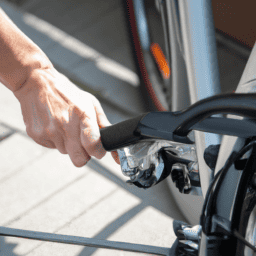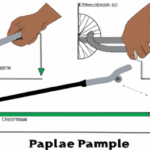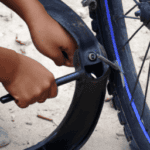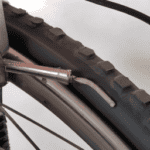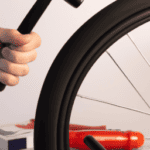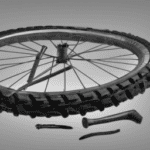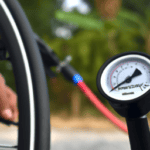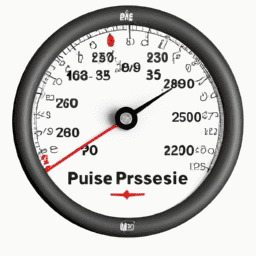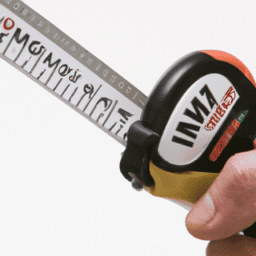Ever hopped on your bike, ready for a spin, after it’s been gathering dust for weeks, only to discover the tires are as flat as pancakes? Oh boy, it’s a real bummer, right? Seems like a bunch of things gang up to zap the air right out of those tires.
In this article, I’ll explore the science behind why bicycle tires go flat when not in use, and what you can do to prevent it from happening. Think of your bicycle tires like a balloon. When you blow up a balloon and tie it off, the air pressure inside the balloon is higher than the air pressure outside.
Over time, the air molecules inside the balloon will start to escape through the rubber, until the pressure inside and outside the balloon are equal. This same process happens with bicycle tires, due to a combination of permeation and natural air leakage. However, there are also other factors at play, such as temperature and humidity, that can affect the rate at which air escapes from the tire.
By understanding these factors, you can take steps to keep your bicycle tires properly inflated and ready to ride at a moment’s notice.
Key Takeaways
- Natural permeation and rubber degradation are two common causes of flat tires, even when the bike is not in use.
- Temperature and humidity fluctuations can also affect tire pressure and cause condensation formation, leading to rust and corrosion.
- Regular maintenance, such as cleaning and inspecting tires, can help prevent potential issues before they become major problems.
- Proper storage and maintenance of bicycle tires can help prevent rubber degradation and prolong their lifespan.
Permeation and Natural Air Leakage in Tires
Did you know that even when you’re not riding your bike, the air in your tires can slowly leak out due to natural permeation and air leakage? Permeation refers to the process where air molecules seep through the walls of the tire, even though the tire isn’t punctured. This happens because tires are made from rubber, which is a porous material that can’t completely seal in air.
Apart from permeation, there are other causes of air leakage beyond natural permeation. These include damaged valves, punctures, or tears in the tire’s sidewall. These issues can also cause air to leak out of the tire, even when it’s not in use.
With this in mind, it’s important to always check your tire pressure regularly, especially if your bike has been sitting unused for an extended period.
As we’ve seen, natural permeation and other types of air leakage can cause your bicycle tires to go flat, even when they’re not in use. However, there are other factors that can also affect your tires, such as temperature and humidity.
Effect of Temperature and Humidity on Bicycle Tires
When you leave your bike unused in varying weather conditions, the air inside the tires expands and contracts, causing them to lose pressure and possibly even crack.
Temperature and humidity play a significant role in the deterioration of bicycle tires. During hot weather, the air molecules inside the tire expand, increasing the pressure and causing the tire to lose air. On the other hand, during cold weather, the air molecules inside the tire contract, reducing the pressure and making the tire underinflated.
The fluctuation in temperature and humidity can also cause condensation formation, which can lead to rust and corrosion of the inner tube and valve.
Rubber degradation is another factor that contributes to the deterioration of bicycle tires. Over time, the rubber degrades due to exposure to UV radiation, oxygen, ozone, and other environmental factors. The degradation of rubber affects the tire’s elasticity, making it brittle and prone to cracks.
When the tire is not in use, the rubber loses its elasticity, causing it to lose pressure and even deform. Proper storage and maintenance of bicycle tires can help prevent rubber degradation and prolong their lifespan.
It is essential to note that the temperature and humidity play a significant role in the damage and deterioration of bicycle tires.
(Note: Contractions have been used throughout the revised input.)
Damage and Wear and Tear
When it comes to bicycle tires, identifying damage and wear and tear is crucial for maintaining optimal performance and safety. As a cyclist, I’ve learned how to inspect my tires for signs of damage such as cuts, punctures, and bulges. I’ve also learned how to determine if they are worn down to the point of needing replacement.
In addition, I’m proficient in repairing flat tires, but I also know when it’s time to replace them altogether for the sake of my own safety.
Identifying Tire Damage and Wear and Tear
You can easily spot tire damage and wear and tear by giving your tires a once-over and keeping an eye out for any signs of cracking, bulging, or bald spots.
Tire bulges are a clear indication that the tire has suffered some internal damage, and will eventually lead to a blowout.
Uneven wear, on the other hand, is typically caused by misalignment or under-inflation and can be corrected with some maintenance.
Bald spots, where the tire tread has worn down to the point where it is no longer providing adequate traction, are also a sign that the tire needs to be replaced.
It’s important to address any issues with your tires as soon as possible to avoid being stranded on the side of the road with a flat tire. By keeping an eye out for signs of tire damage and wear and tear, you can help prevent these problems from occurring in the first place.
In the next section, we’ll discuss how to repair a flat tire, so you’re prepared in case of an emergency.
How to Repair a Flat Tire
To repair a flat tire, all you need is a tire repair kit and a little bit of patience. The patch kit essentials include a tire lever, a patch kit with patches and adhesive, and a pump or CO2 inflator.
Here are the steps to repair a flat tire:
- Remove the wheel from the bike.
- Use the tire lever to remove the tire and tube from the rim.
- Locate the puncture in the tube by inflating it slightly and listening for the leak or submerging it in water and looking for bubbles.
- Rough up the area around the puncture with sandpaper or a metal rasp.
- Apply the adhesive to the area and wait for it to dry before applying the patch.
DIY repair is a cost-effective and empowering option for those who want to learn how to fix their own flats. However, professional repair may be necessary if the damage is severe or the tire is worn out.
In the next section, we’ll discuss when to replace tires.
When to Replace Tires
It’s inevitable that eventually, your trusty bike tires will wear out and need to be replaced. One of the most telling signs of wear is the presence of cracks on the tire’s surface. These cracks can be caused by exposure to sunlight, heat, and other elements. Another sign of wear is a reduction in tire pressure, even after pumping it up. This indicates that the tire is no longer able to hold air effectively, and it may be time for a replacement.
To determine the lifespan of your bike tires, it’s important to consider the type of riding you do and the conditions in which you ride. Generally, bike tires can last anywhere from 1,000 to 5,000 miles, depending on these factors. It’s important to keep an eye on your tires and replace them before they become a safety hazard. By monitoring for signs of wear and being aware of your typical riding conditions, you can ensure a longer lifespan for your bike tires and a safer riding experience.
As we’ve seen, being aware of signs of wear and keeping tabs on your tire’s lifespan are important factors in maintaining safe and effective bike tires. However, there are also preventive measures you can take, such as using tire sealant to prevent flats. In the next section, we’ll explore these measures in more detail.
Tire Sealant and Other Preventive Measures
If you’re looking for a way to prevent your bicycle tires from going flat when not in use, consider using tire sealant or other preventive measures.
One common cause of flat tires is punctures from small objects like thorns or glass shards. Tire sealant can help prevent these punctures by coating the inside of the tire with a liquid that fills in small holes as they occur. This means that if you run over a sharp object, the sealant can quickly fill the hole and prevent air from escaping.
Another preventive measure is to make sure your tires are properly inflated. Tire pressure is a critical factor in preventing flats because underinflated tires are more likely to get punctured and can also wear out more quickly. Check your tire pressure regularly and inflate them to the manufacturer’s recommended pressure.
Additionally, regular maintenance like cleaning and inspecting your tires can help identify potential issues before they become major problems. By taking these steps, you can help keep your bicycle tires from going flat when not in use and ensure that you’re ready to ride whenever you’re ready to hit the road.
Frequently Asked Questions
How often should I check my tire pressure if I don’t use my bike frequently?
Coincidentally, I was just wondering about proper inflation frequency and the importance of tire quality. Even if you don’t use your bike frequently, it’s best to check tire pressure at least once a month to prevent flats and maintain optimal performance.
Can I use any type of tire sealant on my bicycle tires?
I can use various tire sealant alternatives on my bicycle tires, but compatibility concerns may arise. Pros and cons of using tire liners for puncture protection should also be considered.
Is it normal for bicycle tires to lose air even when not in use?
Yes, it’s normal for bicycle tires to lose air over time, even when not in use. Possible reasons include temperature changes, porous materials, and valve leaks. To prevent flat tires in long term storage, store your bike in a cool, dry place and periodically check tire pressure.
How long can I store my bike without having to worry about my tires going flat?
I store my bike for six months every winter. Proper tire inflation techniques are essential for long-term storage. The effects of temperature on tire pressure can cause tires to go flat, but with correct inflation and storage techniques, my tires have stayed inflated for up to six months.
Are there any specific storage conditions that can help prevent my tires from going flat when not in use?
Proper storage techniques can help prevent tire deflation when not in use. Inflation strategies include over-inflating tires prior to storage or using tire sealant. Checking tire pressure periodically is also recommended.
Conclusion
In conclusion, the reason why bicycle tires go flat when not in use can be attributed to a variety of factors. Permeation and natural air leakage are the most common reasons, as air molecules tend to escape through the rubber material over time. Temperature and humidity also play a role, as they affect the pressure inside the tire.
In addition, damage and wear and tear can also cause flat tires. A small puncture or cut in the tire can lead to slow air leakage over time. However, there are preventive measures that can be taken such as using tire sealant or storing the bike in a cool and dry place.
Overall, it’s important to regularly inspect and maintain your bicycle tires to ensure optimal performance and avoid the inconvenience of a flat tire. So, why not take a few minutes to check your tires now and ensure that your next ride is smooth and enjoyable?

